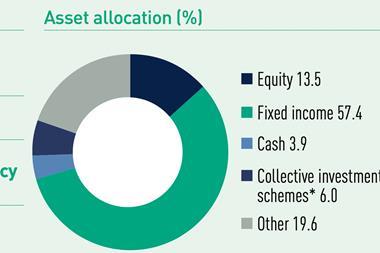The pension funds of banking institutions UBS and Credit Suisse will have to work out solutions on a series of issues involving funding ratios, level of benefits, and investment strategies to close a merger that is seen as having potentially a positive effect on the administration and members of the new merged pension scheme.
UBS announced last week its plan to fully integrate Credit Suisse’s Swiss business, expecting to close the merger next year, with the pension schemes of both banks potentially becoming one.
“The two pension schemes can merge. However, this is a very complex process with a strictly formalised procedure,” according to Heinz Rothacher, chief executive officer of consultancy Complementa.
The merger of pension funds in Switzerland is regulated by article 88 of the Merger Act (Fusiongesetz).
The main steps for a merger include a resolution of the board of trustees on the approval of the merger, merger report, financial statements on the merger, auditors’ report, report of a pension expert explaining that beneficiaries’ rights are preserved, and regulatory authority approval.
“The first step is to obtain approval from the supervisory authority. The primary concern will be to protect the rights of the beneficiaries. The pension funds of both banks are very different. They could still be run separately, but that hardly seems efficient in the long run,” Rothacher said.
The merger of the two Pensionskasse will also require the consent of members, especially after the Federal Supreme Court (Bundesgericht) made it clear that prior to changing the pension fund the consent of staff must be obtained.
“Scant information and a hearing is not sufficient here. Employees must agree to change pension funds. The new UBS [bank] will prepare a proposition, which will be discussed with the staff committee, and members will then have to address it,” Rothacher said.
To protect the rights of all beneficiaries of both pension schemes, a precondition for the merger is that the pension funds, with the same technical basis and the same pension provision policy, have at least in principle an “equal” funding ratio, according to an expert familiar with the merger.
The funding ratios of both pension schemes might look quite different, the source added.
Credit Suisse’s Pensionskasse had an economic funding ratio of 119.3% at the end of last year, according to scheme’s latest financial statement, while the economic funding ratio of the UBS Pensionskasse stood 130.1% as of the end of January this year.
The funding ratio of the Credit Suisse pension fund stood at 128.7% at the end of last year, according to article 44 of the occupation pension law BVV2, the financial statement added.
An harmonisation of both funding ratios may be achieved, for example, by distributing funds from the pension fund with the higher funding ratio to the one with the lower funding ratio, or using the funds to make provisions to improve future benefits for the beneficiaries, the expert added.
The employer may increase the funded status of the pension fund with the lower funding ratio by making contributions.
The new UBS pension fund will also have to deal with the question of the level of benefits and a new investment strategy, according to Complementa’s Rothacher.
“So far, the two investment strategies appear to be very different. UBS will want to present a pension fund that is attractive to [current] and potential employees. UBS’s pension scheme is known for having a high funding ratio. It will therefore be a question of adjusting and, if necessary, balancing the levels of benefits,” he said.
1e plans
A merger of the two pension schemes can also take place with the pension plans currently in place, including 1e plans that are offered by Credit Suisse Pensionskasse but not by UBS.
“The new pension fund can also offer 1e plans. It is currently unclear whether it will happen. Depending on the number and size, certain plans could also be allowed to expire with a transitional period. I assume this is being worked on, but nothing is known at the moment,” Rothacher said.
Credit Suisse’s Pensionskasse 2, with CHF836.1m of assets under management and 9,711 members as of the end of 2022, offers an 1e plan for staff with an annual salary of more than CHF129,060 (as of 2022). It gives members the option of choosing one out of eight investment strategies.
Pensionskasse 2 cannot be merged because 1e plans must be managed by an independent foundation. Therefore, in the event of a merger, either UBS must switch to the 1e plan or the Pensionskasse 2 will have to close, the expert said.
The pension benefits of the two pension funds are designed very differently, and a complete harmonisation is only possible if the 1e plan is adopted by UBS or closed by Credit Suisse.
Benefits of the merger
The merger of both pension funds would mean that all employees are treated equally, it will simplify the pension plans’ architecture, administration and will likely change its investment strategy.
The new, combined pension fund could also offer more choices for members, according to Rothacher.
“UBS has the chance to create something completely new, possibly even groundbreaking. You could make the [pension fund] very attractive, which would be very well received given the current shortage of skilled workers and could give UBS an advantage in terms of recruitment,” he said.
But challenges remain. UBS is listed and reports under the International Financial Reporting Standards’ (IFRS) IAS 19 and therefore the impact on this accounting standard must also be taken into account with regard to changes to the pension plans, according to the expert.
The benefit of a merger of both pension funds would be the simplification of having one pension plan with one board of trustees, one investment strategy, one risk profile, and one funding ratio. Without the merger, different pension plans will remain.
UBS AM gets ’basic’ ESG score
Morningstar has recently published a report on asset managers and their commitment to sustainability, downgrading UBS Asset Management to ‘basic’ from ‘advanced’. UBS is struggling to integrate ESG factors in its asset management business, the report said, adding that the challenges the merger of UBS and Credit Suisse asset management divisions could further hinder UBS’s efforts to progress on ESG.
Analysts have struggled to assess whether sustainability is “deeply embedded” in UBS’s ESG-integrated funds, making up 28% of assets, as managers retain the discretion to invest in companies flagged for high ESG risk, the report added.
UBS has, however, made some progress by excluding companies involved with thermal coal from funds that integrate ESG considerations. The firm’s designated “ESG-focused” funds (17% of assets) also apply additional exclusions related to business controversies.
The firm has boosted its ESG team to more than 30 staff members and is also increasingly using a thematic approach for engagement.
The latest digital edition of IPE’s magazine is now available









































No comments yet